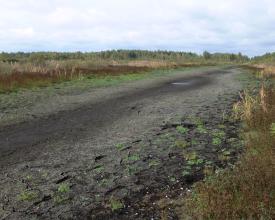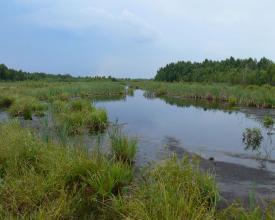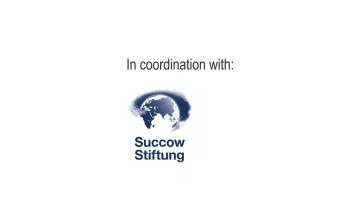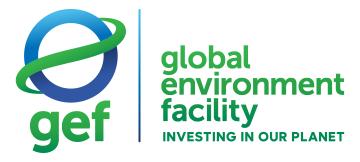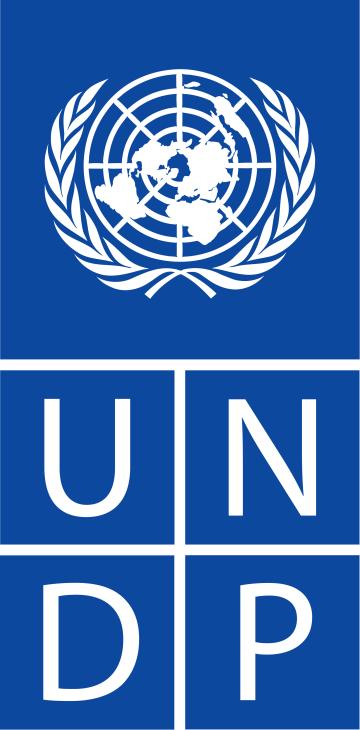
Modelo bielorruso de restauración de turberas templadas
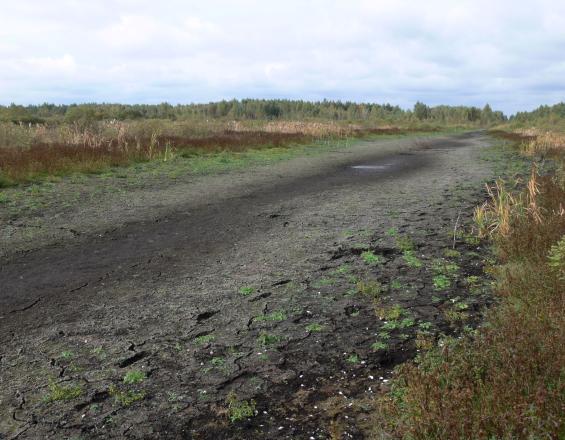
Las turberas templadas albergan numerosas especies amenazadas y son vitales para el desarrollo humano por sus servicios de regulación del clima, regulación de incendios, erosión e inundaciones. Las turberas templadas abundan en Europa y, en particular, en Bielorrusia. Aunque las turberas emiten metano y óxido nitroso, también secuestran dióxido de carbono y, a largo plazo, las turberas prístinas enfrían el clima. Sin embargo, una vez que las turberas prístinas son alteradas por el drenaje para combustible o para cultivos herbáceos, el carbono que almacenan se libera a la atmósfera a través de la oxidación de la turba y los incendios. Más de 1,5 millones de hectáreas de turberas de Bielorrusia han sido desecadas en el pasado. El PNUD se asoció con el Gobierno de Bielorrusia y organizaciones internacionales para crear un modelo de rehabilitación de turberas. Desde el inicio de estas actividades en 2009, se han restaurado más de 50.000 ha de turberas. Las poblaciones de aves acuáticas se han estabilizado en los lugares restaurados y la mineralización de la turba y los incendios han cesado casi por completo.
Contexto
Défis à relever
Las turberas templadas son uno de los recursos naturales irremplazables del mundo. Albergan numerosas especies amenazadas y son una de las principales reservas de carbono del planeta. En Bielorrusia, las turberas cubren unos 2,6 millones de hectáreas, de las cuales más de 1,5 millones se han degradado. Esto se debió a la perturbación a gran escala del régimen hidrológico de estos ecosistemas tras el drenaje para la extracción a escala industrial de turba para combustible en el pasado. La pérdida de turberas supuso una amenaza para varias especies amenazadas: por ejemplo, el carricerín cejudo, que tiene en las turberas de Bielorrusia más del 60% de su población mundial. En 2009 aumentó la presión para destinar nuevas tierras -incluso en zonas protegidas- a la extracción de turba. Extensas zonas de turberas explotadas permanecían abandonadas, lo que aumentaba el riesgo de incendios de turba. Una investigación financiada por el PNUD en 2009 demostró la urgente necesidad de tomar medidas inmediatas para restaurar la integridad ecológica de las turberas degradadas con el fin de conservar la biodiversidad, reducir las emisiones de carbono y eliminar los riesgos para la salud.
Ubicación
Procesar
Resumen del proceso
Los tres bloques son consecutivos. Es necesario investigar el problema y proponer una solución técnica (Bloque 1). Luego hay que demostrar esa solución sobre el terreno (Bloque 2). Por último, cuando se demuestre la eficacia de los dos bloques anteriores, habrá llegado el momento de fijar la sostenibilidad a largo plazo y la replicación, lo que en el caso de Bielorrusia se hizo mediante la adopción del Plan de Acción para Todas las Turberas por parte del Consejo de Ministros (Bloque 3).
En 2019, más de 32.000 ha de turberas de Bielorrusia se habrán restaurado adicionalmente sin la participación de ningún donante, además de las 22.397 ha previstas en el proyecto del FMAM. Así pues, la superficie total de turberas degradadas en Bielorrusia se reduce cada año, devolviendo la vida a estos ecosistemas únicos.
Los conocimientos técnicos de Bielorrusia, desarrollados por el equipo del Dr. Kozulin, se han aplicado en Rusia, en el marco de proyectos financiados por la Iniciativa Internacional sobre el Clima de Alemania y ejecutados conjuntamente con Wetlands International y los gobiernos locales. En 2019 se han restaurado más de 40.000 ha de turberas en Rusia utilizando estos conocimientos. La metodología del Dr. Kozulin también fue utilizada por el Proyecto ClimaEast en Ucrania, que restauró alrededor de 3.000 ha de turberas agrícolas.
Bloques de construcción
Conocimientos de restauración
Se elaboró una guía técnica sobre enfoques asequibles para la restauración de turberas. El principal reto era reunir a especialistas de distintos campos (hidrología, biología, edafología, economía) para que colaboraran en el desarrollo de una única solución lo más sostenible posible para cada turbera; el proceso, por tanto, implicó mucho aprendizaje y contó con el asesoramiento de expertos alemanes y británicos. El know-how resultante fue aprobado como Código de Buenas Prácticas, convirtiéndose en una norma en la restauración de turberas en Bielorrusia. El enfoque de la restauración se basa en el uso de material local y, en muy pocos casos, en construcciones más sólidas (hormigón) para bloquear las zanjas de drenaje e impedir así que el agua se escurra por las turberas. Las construcciones de bloqueo pueden regularse en caso necesario, lo que permite ajustar el nivel del agua en la turbera según las necesidades. Se ha desarrollado un algoritmo para determinar cuántas construcciones de este tipo habría que colocar y dónde, en función del tamaño de la zona, la elevación y el estado de las zanjas de drenaje. (Para más detalles sobre los aspectos técnicos del planteamiento de restauración, consúltese la propia Guía). La rehumidificación de las turberas templadas, desarrollada por un equipo de especialistas dirigido por el Dr. Alexander Kozulin, puede evitar las emisiones, restablecer la hidrología, recrear el hábitat de las aves acuáticas y provocar el reinicio de la acumulación de turba.
Factores facilitadores
- especialistas de diferentes campos (hidrología, biología, ciencias del suelo, economía) dispuestos a aprender y colaborar para desarrollar una única solución sostenible para cada turbera concreta,
- asesoramiento por parte de destacados investigadores en turberas (Instituto Greifwald, Alemania, y RSPB, Reino Unido),
- Gobiernos dispuestos a aceptar una gestión sostenible de los recursos naturales a largo plazo frente a los posibles beneficios a corto plazo que puedan derivarse del uso inmediato de las turberas para combustible o agricultura.
Lección aprendida
- Para que la rehumectación tenga éxito, es necesario modelizar cuidadosamente la altitud del terreno, especialmente cuando se producen cambios altitudinales significativos en la turbera.
- Después de la rehumectación, es necesario supervisar cuidadosamente las instalaciones hidrotécnicas para asegurarse de que funcionan exactamente según lo previsto y repararlas a tiempo en caso necesario.
- Es importante que las instalaciones hidrotécnicas construidas como parte de la rehumidificación tengan un propietario/gestor claro, responsable de su mantenimiento y de la observancia del nivel de la capa freática tras la restauración.
- El coste de la restauración puede variar. El caso de Bielorrusia ha demostrado que no es necesario realizar costosas obras de construcción (los materiales locales pueden servir perfectamente para este propósito), ni tampoco es necesaria una revegetación / resiembra asistida; la mayoría de las comunidades de los humedales regresan junto con el retorno de las aguas subterráneas.
Encontrará más información técnica (con ejemplos e imágenes) en la Guía de restauración de turberas, cuyo enlace se ha facilitado.
Demostrar la restauración in situ
Con la cofinanciación del Fondo para el Medio Ambiente Mundial, entre 2009 y 2011 se restauraron 22.397 ha de turberas degradadas. La restauración en estos 10 lugares ayudó a detener la emisión anual de unas 448.000 toneladas de CO2 procedentes de los incendios y la mineralización de las turberas, y a ahorrar al país decenas de millones de dólares en operaciones de extinción de incendios. Ya un año después de la rehabilitación, la mayoría de los lugares mostraban el resurgimiento de la vegetación típica de los humedales (principalmente comunidades de juncia) y su dominio sobre árboles y arbustos (fotos adjuntas). La densidad de aves acuáticas aumentó entre un 12% y un 16%. En los humedales recreados, los científicos registraron la presencia del carricerín cejudo (VU), el águila moteada (VU) y la aguja colinegra (NT), que figuran en la lista de la UICN, así como de otras especies de humedales que antes se habían perdido en estas zonas, como la agachadiza común, el escribano palustre, la avefría, el carricerín cejudo y el carricerín cejudo. El coste de la restauración (desde el diseño técnico hasta el restablecimiento del nivel del agua) ha sido de unos 50 dólares por hectárea. La restauración se ha llevado a cabo principalmente con materiales y mano de obra locales. Desde 2011, la restauración de turberas en otros lugares ha continuado sin ayuda de donantes externos.
Factores facilitadores
- La adopción y aceptación de las normas técnicas mencionadas en el bloque anterior es importante para el éxito de la restauración sobre el terreno.
Lección aprendida
- La rehumidificación de las turberas mediante el cierre de los canales y zanjas de drenaje es una solución natural que constituye la única forma eficaz de hacer frente a los incendios de turba. El agua vuelve aunque parezca que ha desaparecido por completo de la turbera.
Resolver el futuro de todas las turberas de Bielorrusia.
Una vez reconocidos a escala nacional los beneficios medioambientales, económicos y sanitarios de la restauración, el Consejo de Ministros adoptó en 2015 la Estrategia para el uso sostenible y la categorización de todas las turberas. Esta política impide cualquier pérdida futura de turberas, permitiendo la extracción de turba solo cuando no se cause pérdida de biodiversidad y exigiendo la rehumidificación obligatoria tras la extracción o el uso agrícola. La propiedad y la gestión de las turberas durante su uso/protección, durante y después de la restauración, así como el mecanismo de ahorro para reservar fondos para la restauración, se han aclarado en la normativa nacional.
Factores facilitadores
- La demostración clara de los beneficios económicos y medioambientales mediante demostraciones sobre el terreno es el argumento más convincente para que el Gobierno adopte una decisión a largo plazo favorable para el ecosistema y las personas.
- Pasaron unos 10 años entre los primeros estudios sobre la pérdida de biodiversidad en las turberas y la adopción de la visión a largo plazo para la sostenibilidad de las turberas. El tiempo es un factor importante para lograr un cambio transformador positivo.
Lección aprendida
- es posible resolver una cuestión tan compleja como ésta, cuando el Gobierno, las comunidades internacionales y los investigadores se unen y acuerdan avanzar hacia un objetivo común.
Impactos
- La restauración de 1 ha de una turbera templada degradada evita la liberación de aprox. 5,5 CO2-eq/año.
- No se produjeron incendios en las zonas restauradas.
- Todos los lugares restaurados muestran una rápida reaparición (2 años después de la restauración) de la vegetación de los humedales y el regreso de las aves acuáticas.
- Muchas zonas restauradas se han convertido en populares atracciones turísticas, lugares de pesca para aficionados y lugares de recogida de arándanos.
- Estabilización de las comunidades de juncos y de especies de aves acuáticas como el carricerín cejudo, el águila moteada y el guión de codornices.
Beneficiarios
- Especies globalmente amenazadas (carricerín cejudo, águila moteada, plantas raras).
- El Gobierno, como responsable de los costes de la lucha contra los incendios de turba.
- Las comunidades locales, que no han podido beneficiarse de las turberas en estado degradado.
Objetivos de Desarrollo Sostenible
Historia
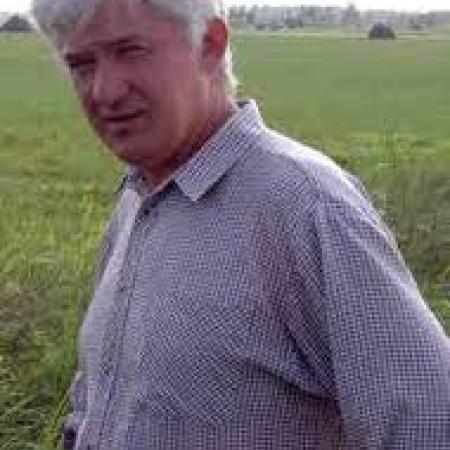
Belarús solía describirse como el "país de las turberas". Mi infancia transcurrió rodeada de turberas y bosques. De pequeño, iba a cazar con mi padre y mi hermano mayor, y a recoger arándanos con mi madre y las mujeres del pueblo. Estos años de formación en el campo determinaron mi trayectoria vital. En los años 90, cuando investigaba en la Academia de Ciencias, observamos un descenso en el número de muchas especies de aves acuáticas. Nuestras investigaciones demostraron que esto estaba correlacionado con la degradación de los ecosistemas de turberas, resultado del drenaje. Los efectos incesantes del drenaje eran responsables de la pérdida de suelo, vegetación y hábitat de las especies, así como de los incendios de turba. Corríamos el riesgo de perder poblaciones de especies, como el carricerín cejudo, de las que nuestro país es globalmente responsable: nuestras turberas albergan más del 60% de su población mundial. También perdíamos poblaciones de águila moteada, guión de codornices y numerosas plantas raras. Millones de hectáreas de tierra quedaron abandonadas y se incendiaron, afectando a la salud de las personas, liberando toneladas de carbono al aire y suponiendo millones de dólares de inversión en operaciones de extinción de incendios. En 2008 esta situación distaba mucho de ser sostenible, así que cuando, tras completar nuestros estudios, nos asociamos con el PNUD, el Fondo para el Medio Ambiente Mundial y varias ONG, las cosas empezaron a cambiar. Hemos trabajado paso a paso desde entonces hasta 2019 para resolver el problema. Encontramos la manera de devolver la vida a las turberas, rehumedeciéndolas. Desarrollamos las políticas y soluciones técnicas necesarias y demostramos su viabilidad. El resultado fue que las autoridades, y la gente en general, se dieron cuenta de que la rehumidificación es una de las formas más eficaces de tratar las turberas degradadas. Como resultado, el Consejo de Ministros nacional adoptó la Estrategia para el Uso Sostenible y la Categorización de las Turberas, elaborada con aportaciones detalladas de un equipo de expertos técnicos y representantes de diversas instituciones responsables de la protección o el uso de las turberas. Cuando empecé este trabajo, mi sueño era que Bielorrusia volviera a ser la "tierra de las turberas", con beneficios para nuestra gente, nuestra biodiversidad y el clima. Me satisface enormemente ver cómo ese sueño se hace realidad".

